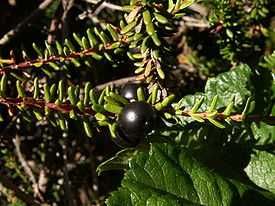Empetrum nigrum
| Black crowberry | |
|---|---|
 | |
| Black crowberry growing in a raised bog | |
| Scientific classification | |
| Kingdom: | Plantae |
| (unranked): | Angiosperms |
| (unranked): | Eudicots |
| (unranked): | Asterids |
| Order: | Ericales |
| Family: | Ericaceae |
| Genus: | Empetrum |
| Species: | E. nigrum |
| Binomial name | |
| Empetrum nigrum L.[1] | |
Empetrum nigrum, crowberry or black crowberry, is a species of Empetrum which is native to most northern areas of the northern hemisphere.[2][3] It is usually dioecious, but there is a bisexual tetraploid subspecies, Empetrum nigrum ssp. hermaphroditum that occurs in more northerly locations and at higher altitude.[4][5]
In gardening, it can be grown in acidic soils in shady, moist areas. It can be used for the edible berries, for a purple dye, or as a ground cover.[6]
The metabolism and photosynthetic parameters of Empretrum can be altered in winter-warming experiments [7]

Uses
In subarctic areas, Empetrum nigrum has been a vital addition to the diet of the Inuit and the Sami. After waning popularity, the crowberry is regaining its reputation as an edible berry. It provides a steady crop and the gathering is relatively easy. The high concentration of anthocyanin pigment can be used as a natural food dye. The Dena'ina (Tanaina) harvest it for food, sometimes storing in quantity for winter, and like it mixed with lard or oil. They keep well in a cool place without any special preparation.
The berries are usually collected in the fall of the year but if not picked they may persist on the plant and can be picked in the spring. The Inuit and Native Americans mix them with other berries, especially the blueberry. Cooking enhances the flavor. They make good pie and jam.
The leaves and stems are used in Dena'ina medicine for diarrhea and stomach problems; they are boiled or soaked in hot water, and the strained liquid drunk. Some claim the berry juice is good for kidney trouble.

In Dena'ina plantlore in the Outer and Upper Inlet area of Lake Clark, the root is also used as a medicine, being used to remove a growth on an eye and to heal sore eyes. The roots are boiled and the eyes are washed with the strained, cooled tea, to which a little sugar may be added. Some people say blackberry stems can be used in the same way for these ailments.
In Labrador, where the name "blackberry" is used, the smoke of the burning stems and leaves is used to smoke fish, notably Salmon, Sea Trout and Arctic Char.
Crowberries contain mostly water. Their vitamin content is low, as is also the concentration of volatile liquids, the lack of which makes them almost odorless. The acidity is lower than is typically encountered in forest berries, and benzene acids are almost absent.
Crowberries are also occasionally grown as ornamental plants in rockeries, notably the yellow-foliage cultivar Empetrum nigrum 'Lucia' (photo, left).
References
- ↑ Sp. Pl. 2: 1022. 1753 [1 May 1753] "Plant Name Details for Empetrum nigrum". IPNI. Retrieved December 1, 2009.
- ↑ "Empetrum nigrum L.". Germplasm Resources Information Network (GRIN). United States Department of Agriculture.
- ↑ "Empetrum nigrum L.". PLANTS.
- ↑ Stace, CA (2010) New Flora of the British Isles, 3rd edition. Cambridge University press. ISBN978-0-521-70772-5. pp. 525
- ↑ http://linnaeus.nrm.se/flora/di/erica/empet/empenig.html
- ↑ "Empetrum nigrum - L.". Plants for a Future.
- ↑ Bokhorst S, Bjerke JW, Davey MP, Taulavuori K, Taulavuori E, Laine K, Callaghan TV, Phoenix GK. 2010. Impacts of extreme winter warming events on plant physiology in a sub-Arctic heath community. Physiologia Plantarum. 140(2): 128-140.
External links
| Wikimedia Commons has media related to Empetrum nigrum. |